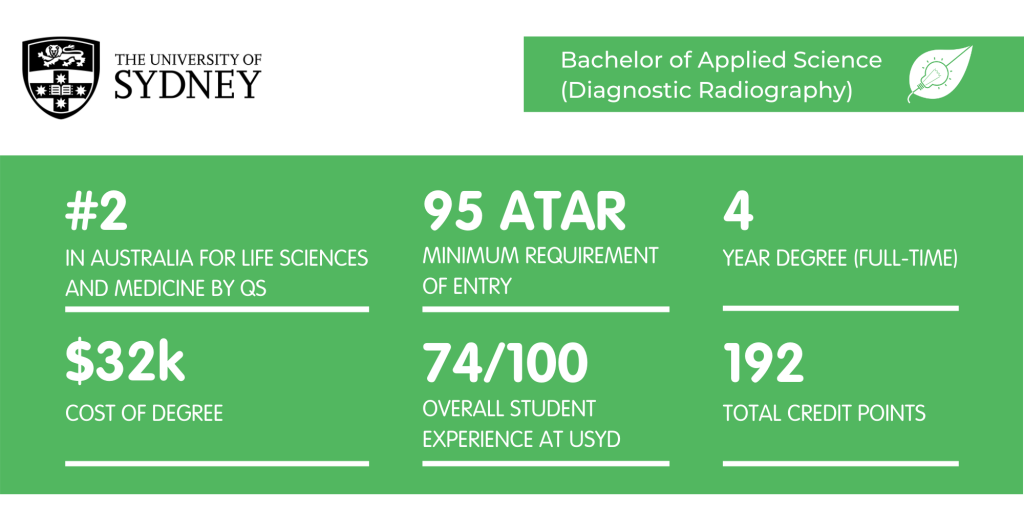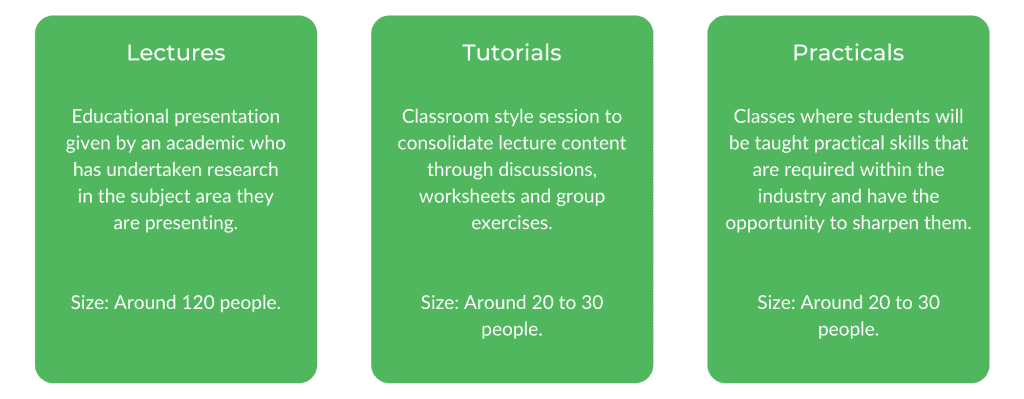So you’re interested in studying a Bachelor of Applied Science (Diagnostic Radiography) at USYD and don’t know where to start?
This article will give you a rundown on what to expect with this degree, including the basic course structure, classes, university culture, internships and career paths.
Continue reading as we dive in!
What is a Bachelor of Applied Science (Diagnostic Radiography) at USYD?
Core Units for this Degree
How to Get into Diagnostic Radiography at USYD
What’s the Teaching Format?
What’s the Faculty and Culture Like?
What is a Bachelor of Applied Science (Diagnostic Radiography) at the USYD?
A Bachelor of Applied Science (Diagnostic Radiography) will teach you the skills and understanding to produce high-quality medical images (X-ray scans) with the latest technology, to assist the diagnosis of illnesses and injuries. It is a practical science degree that combines theoretical content with technical skills, both through in-class laboratory activities, and significant professional and clinical work experience over the course of your degree.
What can you expect from studying Diagnostic Radiography at USYD?
If you’re planning on studying Diagnostic Radiography at USYD, you can expect to learn how to develop a technical skill set that maximises your potential to help others in the field of medical diagnosis. You can also expect a lot of applied learning and time spent outside of uni in the field, as opposed to purely lecture and classroom settings.
If you enjoy hands-on learning and potentially challenging new environments, this course is for you!
Career Paths
Studying this degree gives graduates a range of career opportunities, from working in small regional to large city hospital departments and clinics, as well as other academic or educational settings.
Radiography is not the formal diagnosis of illness itself via written reports. Radiographers mainly operate the relevant technologies for diagnosis — however students will also gain a solid foundation of image evaluation in their course!
A few of the most significant career paths for a Bachelor of Applied Science (Diagnostic Radiography) are:
-
- Imaging departments
- Intensive care departments
- Emergency departments
- Surgery theatre
- Private practice
- Research
- Education
Students interested in further study (at a Masters or Honours level) will also broaden their career prospects. For example, furthering one’s study through a Masters of Medical Imaging Science provides entry into fields such as mammography/ultrasound.
Core Units for this Degree
What are the subjects for Diagnostic Radiography at USYD like?
Students studying this degree are required to study a combination of ‘core’ diagnostic radiography units, biology units, and ‘health, behaviour and society’ units (along with elective units from a shared health sciences pool).
HSBH1003 Health, Behaviour and Society and HSBH3001 Health and Indigenous Populations, while not core subjects, are compulsory in first and third years of Diagnostic Radiography, where students learn about how social and psychological factors inform individuals’ medical decisions.
As the degree progresses, students can expect to be engaging more specifically in diagnostic radiography core units (i.e. exclusive to their degree) and fewer units from these other areas. However they may choose to take health science electives in their elective slots, tailoring their degree to their interests.
What are the Core Units?
The core units for Diagnostic Radiography focus on the various concepts and skills you will need to appropriately use technology to accurately diagnose illness. For example, in first year MRTY1031 Radiation Physics focuses on the specific parts of physics relevant to X-ray technology, while MRTY1037 Imaging Technology 1 establishes students’ knowledge of digital radiographic systems (built on later with MRTY2107 Imaging Technology 2).
Another key aspect of Diagnostic Radiography includes the Radiography Work Integrated Learning core units in second to fourth year, where students will experience professional work placement with a choice of urban and regional, and private and public hospital locations.
The full list of units of study for this degree and their descriptions can be found here!
Internships and Work Placement
Students of a Bachelor of Applied Science (Diagnostic Radiography) must do a compulsory 1680 work experience hours by the end of their degree. Luckily, this is built into the degree, with one Integrated Learning unit per semester for second and third year, followed by two in both semesters of their fourth year.
Work experience is a unique and exciting opportunity for students to gain a practical, realistic understanding of a medical professional career while developing their skills. It will stretch you outside textbook-style patient scenarios with both observation of a medical supervisor and practical experience in radiographic imaging at your chosen location.
Some prior locations for work experience have included Leeton, Bankstown and Campsie (urban and regional).
How to Get into a Diagnostic Radiography at USYD
The ATAR requirement for this degree is 95 guaranteed, however you may be able to transfer into the degree after one year from another degree either at USYD or from a Group Of Eight university.
Click here for more info on transferring into this degree from other degrees!
Assumed Knowledge
Mathematics is considered to be assumed knowledge, alongside either Biology, Chemistry or Physics. Although they aren’t prerequisites, students may struggle particularly in their first year with subjects like MRTY1031 Medical Radiation Physics and BIOS1155 Structure, Function and Disease A without this prior study.
Scholarships
There are no specific scholarships available for this degree, however a full list of scholarships for students applying for study in the Faculty of Science at the University of Sydney can be found here.
What’s the Teaching Format?
USYD operates on a semester basis (2 sessions per year, starting March and September).
However, Bachelor of Applied Science (Diagnostic Radiography) students can expect 10 weeks of study followed by 1 week of STUVAC (student study break) and 1 week of final exams. This condensed semester structure is necessary to fit in their Integrated Learning hours per semester for second year onwards — though it can be intense!
Class Structure
Lectures
These classes are mainly informative presentations given by experts in the field on relevant topics to Diagnostic Radiography. The usually run for 2 hours and have 120 students in attendance.
Tutorials
Tutorials for a Bachelor of Applied Science (Diagnostic Radiography) range from more typical classroom activities to more hands-on ones depending on the subject. For example, anatomy (biology) units in first year involve wet lab tutorials where you’ll be investigating real anatomy on human bodies and labelling them, while health, behaviour and society units emphasise class discussion about human issues, as well as group presentations.
Additionally, in your core Diagnostic Radiography subjects you’ll be required to complete high school style questions in groups of four or so and hand in to your tutors in subjects like physics, or analyse X-ray images provided by the tutor for radiograph evaluation, amongst other activities!
Tutes will typically go for 1 hour and around 20 to 30 students attending.
Practicals
To complement the theory that you learn, you’ll also have pracs which are mainly for the physics components of Radiography. You’ll experiment in groups using technological equipment to better understand concepts taught in tutorials and lectures.
Pracs will often run for 2 hours, and are similar in size to tutes with 20 to 30 students attending.
How much time do you spend at uni?
You can expect to spend roughly 15 to 20 hours on campus per week in your first year of studying Diagnostic Radiography at USYD. However, as the degree progresses you will spend more time off-campus engaging in your integrated study units (work-place experience).
One integrated learning unit (in one semester) alone is around 35 hours per week; in fourth year, you will do two of these in both semester one and two!
Also remember that students can and do choose to come into uni in their free time for the variety of society-culture events this degree boasts, discussed later in this article!
Assessments
The assessment style for a Bachelor of Applied Science (Diagnostic Radiography) ranges between exams, hand-ins and presentations. Students are required to sit mid-sem and final exams for their degree including multiple choice, short and long answer responses.
For their 2 HSBH units (health, behaviour and society) students will be required to complete group-presentations. Additionally, in fourth year, students of Applied Science (diagnostic radiography) will complete a capstone project, including a researched report on an area of radiographic science of their choice.
Students will also be assessed by their supervisors at the various locations of work placement for their second, third and fourth year integrated learning units.
Skills that You Develop
Throughout the Degree
In first year, students will learn the basic skills and foundational knowledge of X-ray technologies and scanning processes.
In second year, students can expect to learn more about different projections for different regions of the body (including upper and lower legs, hands forearm lower, abdomen) in their core units of study (MRTY2101 Radiographic Science 1 and MRTY2105 Radiographic Science 2).
Students will also learn basic skills of evaluating general radiographic images for quality, and identify anatomical structures, injuries and diseases in subjects like MRTY2106 Radiographic Evaluation 1 and 2.
Placements
In your second and third year work placements, you will gain a practical understanding of a radiographer’s job through observation and practice. This includes important interpersonal skills such as communicating with other medical staff (GPs, radiologists, doctors, nurses) and patients that are difficult to replicate in the classroom, and preparing you to handle unexpected or difficult patient based scenarios.
Third and Fourth Year
In your third and fourth years, you will learn more complex specialised radiography methods to detect particular illnesses (e.g breast or cardiovascular illnesses), or analyse different age groups. Students must also engage in a self-directed Capstone project in fourth year that is part of their core study, investigating a particular area of medical radiation science of their choosing (MRTY4043 Professional Capstone).
What’s the Faculty and Culture like?
Faculty and Culture
The Bachelor of Applied Science (Diagnostic Radiography) at USYD hosts a supportive faculty of educators. Additionally, the small size of the cohort means everyone becomes familiar with each other by the end of first year.
The smart, hard working culture of the degree means people are helpful and friendly; study groups are common as you work through often challenging content.
The uni’s Biology Society (BioSoc) and Science Society (SciSoc) are excellent opportunities to engage in uni life, meet new people and even take on roles outside of your degree! Both societies are highly active on social media, and offer a range of events including balls, competitions, free food, yoga, academic coaching, and meme-posting for your first year (and beyond).
Exchange Opportunities
Unfortunately, students studying a Bachelor of Applied Science (DIagnostic Radiography) rarely have the time to go on long term exchange (semester or year long) due to their compulsory work experience requirements in second to fourth year.
However, you may apply for shorter study abroad experiences such as the Open Learning Environment’s ‘Experience’ units (all USYD students are required to complete a certain number of OLEs by the end of their degree), which will allow you to travel to a country over one of the university breaks.
Zara Zadro is a Content Writer for Art of Smart and a current undergraduate student at the University of Sydney. She studies a Bachelor of Arts/Advanced Studies majoring in Media & Communications and English. In her free time, she enjoys reading, listening to music and discovering new parts of Sydney. She has also written for the student publications Honi Soit and Vertigo. After she graduates, Zara hopes to do a Masters in creative writing and live overseas, which she cannot wait for!






